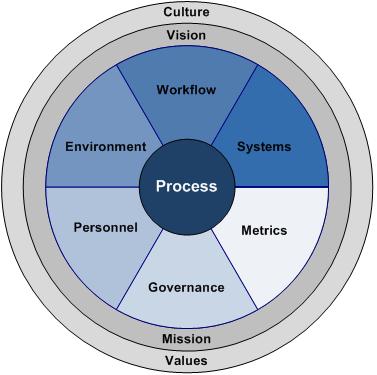The Big Picture
To be effective, process improvement efforts must consider processes in their proper organizational context and, as such, consider not just the workflow and systems that typify traditional process audits, but include assessments of the metrics, governance, personnel and environment that impact the process as well. Further, an organization's mission, vision, values and culture can have a profound influence on any change initiative. As such, they, too, should be considered.
The diagram below illustrates this point and is the "logo" for process improvement engagements we undertake at Perr&Knight.

Workflow, or the sequence of activities that yield a particular result within the organization, should be mapped in an effort to deconstruct the process. This initial process analysis seeks to identify excessive handoffs, sources of error, causes of delay and rework and other impediments to efficient process flow.
Systems are an increasingly critical consideration when improving processes. The intensity of information flows and criticality of document management in insurance operations is a big concern. Which systems are currently in place to support the process? How are they supported? Are they integrated? What innovations should you be aware of?
Metrics – those numbers management so diligently monitors to indicate whether the company is on the right track – provide important guidelines for process improvement objectives. An insurance company focused on being a low-cost provider to its customers will have a different take on key metrics than one that is committed to super-servicing theirs. Some will watch the top line – pushing for growth in premiums as a prime objective – while others might emphasize cost savings, operational efficiency and better margins. Those metrics that are given the most weight will have a significant influence on the direction of process improvement initiatives.
Governance also impacts improvement efforts. Many processes suffer inefficiencies due to statutory imperatives. There’s not much you can do about those, and they must, of course, be considered when designing an improvement initiative. Internal policies, however, are often malleable, and as such should be looked at with an open mind to see if any are unnecessarily constraining. Policies, rules and regulations all exert influence on process effectiveness and efficiency.
Personnel functions are also major enablers of excellent processes. Good hiring practices facilitate the identification of process thinkers from any pool of available resources. A thorough, methodical approach to training will ensure a level of uniformity in the way work gets done, and in organizations that embrace continuous process improvement, that uniform way is a best practice. Further, how are employees being compensated or otherwise rewarded for working in a manner consistent with the larger goals of the organization? All good work begins with the quality of the people who are charged with performing it. The quality of those who perform the work is enhanced through good, selective hiring practices, well thought-out, formal training and rewards that are solidly aligned with corporate objectives.
Environment must be considered as well. Internal factors, such as the corporate structure and physical facilities, as well as external factors, including target markets and the economic factors that influence them, will all play a hand in shaping processes. The deliverable from this audit includes basic floor plans and organizational charts and discussions of the facilities, markets and economic factors impacting the process.
Taking a holistic approach to the enterprise greatly increases the efficacy of the program and typically yields in far greater improvement, better departmental integration and enthusiastic support for organizational change initiatives.


0 Comments:
Post a Comment
Note: Only a member of this blog may post a comment.
Subscribe to Post Comments [Atom]
<< Home